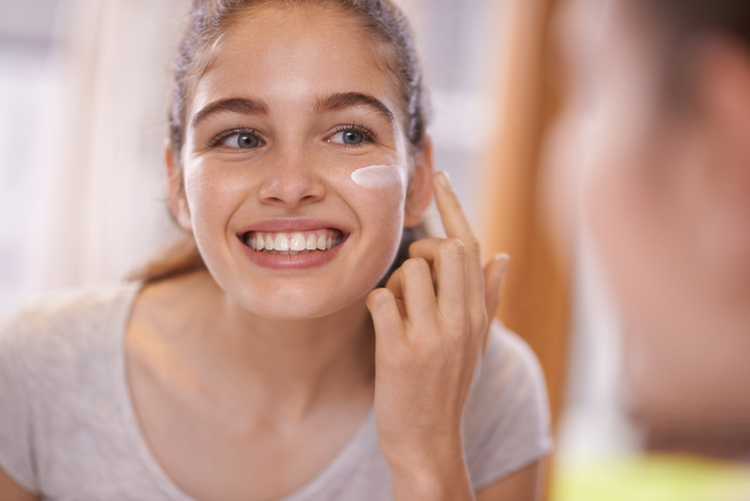Under your skin
In Advice
Follow this topic
Bookmark
Record learning outcomes
Skin problems are common, with around 60% of us experiencing one in our lifetime, according to the British Skin Foundation. Conditions such as acne and psoriasis can cause huge distress and have psychological as well as physical effects on sufferers, so a sensitive approach with customers is essential.

ACNE
Acne affects 80% of us at some time. It most commonly occurs in adolescence, though some have it throughout adulthood. €Acne, spots, blemishes and breakouts are all terms for the same skin problem €“ acne. It is caused by hormones and increased harmful bacteria, which lead to oily skin, blackheads, whiteheads and inflamed spots,€ says Dr Nick Lowe, consultant dermatologist at London's Cranley Clinic and author of Perfectly clear: the perfect guide to clear skin. €There is often a genetic element, but it's the changing androgen hormone levels that trigger the condition. Polycystic ovaries are the other main cause of acne in adult women,€ he adds.
Signs to look for
Oily skin, blackheads, whiteheads and inflamed red spots are all common. In severe cases, inflamed spots can burst and cause scars. These customers should be referred to their GP for prescription treatments.
Lifestyle tips
€¢ Learn relaxation techniques, as stress is a major trigger
€¢ Chose non-comedogenic skin care and cosmetic products to avoid blocking the oil glands
€¢ Reduce intake of processed, refined carbohydrates to help reduce the action of androgen hormones
€¢ Pick slow-release carbohydrates (beans, soy, nuts, wholegrain foods, fruit and vegetables) to keep blood sugar levels balanced.
Daily skin care routine
Don't be tempted to over-cleanse, warns Dr Lowe: €Cleanse morning and evening with a gentle oil-reducing product, but avoid alcohol-containing products that dry out and irritate skin.€ Follow with an anti-acne serum and/or day cream. Apply an acne treatment at night, according to the instructions. Ingredients to look for in OTC products that may help improve acne symptoms include salicylic acid, benzoyl peroxide, retinoids (retinol, retinaldehyde, retinyl palmitate), sulphur, niacinamide and eucalyptus oil.
Products to recommend
Dr. Nick Lowe Acclenz Advanced Action Spot Gel (RRP £20); Neutrogena Visibly Clear Spot Proofing Daily Wash (RRP £4.99); Clearasil Ultra Rapid Action Treatment Cream (RRP £6.85); Dermalex Acne Treatment (RRP £18.99).
ROSACEA
Most common after the age of 30, rosacea causes facial redness, flushing, spots and visible blood vessels. It mainly affects the face. €Blood vessels become hypersensitive to certain triggers and dilate easily, releasing inflammatory chemicals that then cause spots,€ says Dr Lowe.
Signs to look for
Rosacea spots are different to acne spots €“ rather than black or whiteheads, rosacea is typified by red, inflamed bumps. Skin with rosacea is dry and flaky, rather than oily. Other symptoms include persistent redness, raised red patches and thickened skin.
Lifestyle tips
€¢ Find your triggers and avoid where possible. Common ones include sunlight, stress, hot or cold weather, strenuous exercise, alcohol, spicy foods, hot baths and hot drinks.
€¢ €Use sunscreen daily, applying it after rosacea cream,€ says Dr Lowe
€¢ Protect skin from cold wind. Daily skin care routine
€¢ Gently cleanse twice daily with a soap-free cleanser
€¢ Look for products designed for sensitive skin
€¢ Apply moisturiser daily
€¢ Avoid alcohol-based products
€¢ For men, an electric shaver may be less irritating than a razor. Ingredients to look for in OTC products for rosacea-prone skin include metronidazole and azeleic acid. More severe rosacea may need oral antibiotics to reduce inflammation, so refer customers to their GP.
Products to recommend
La Roche-Posay Rosaliac CC Cream (RRP £19.50); La Roche-Posay Rosaliac AR Intense (£17); Dermalex Rosacea Cream (RRP £18.99).
PSORIASIS
€Unlike eczema, which often starts in childhood, psoriasis usually starts in the teenage years and beyond. Over a third of sufferers have a family history of the condition,€ says Dr Emma Wedgeworth, consultant dermatologist and British Skin Foundation spokesperson.
Commonly affected areas are the scalp, elbows, knees, belly button and nails. The condition speeds up the cell renewal process, causing thickened scaly plaques on the skin's surface that can itch, sting and burn.
Signs to look for
Patches of psoriasis (plaques) are raised, red patches of skin covered with silvery scales. These can vary in size and shape. Skin is often itchy and sore. Lifestyle tips €Maintain a healthy weight, don't smoke and reduce alcohol intake,€ says Dr Wedgeworth. Reduce the increased risk of type 2 diabetes and heart disease associated with psoriasis by taking regular exercise and eating healthily.
Daily skin care routine
€It's essential that skin is kept well hydrated to avoid excess flaking and inflammation,€ says Dr Wedgeworth.
Emollients should be applied daily to skin. Wait at least 20 minutes before applying a topical treatment after an emollient.
Vitamin D analogue creams are commonly used with, or instead of, steroid creams for mild to moderate psoriasis.
Coal tar is a commonly used ingredient in psoriasis treatments.
Products to recommend
Exorex Moisturising Cream (RRP £6.99); Cetaphil Moisturising Lotion (RRP £8.99); Neutrogena T/Gel Therapeutic Shampoo (RRP from £5).
ECZEMA
Eczema causes itchy, dry, red and inflamed skin. It usually first appears in children before the age of one and can persist throughout adulthood. People with eczema also commonly suffer from allergic conditions such as hayfever and asthma. €We know that some people are more genetically prone to eczema and those with drier skin are more likely to have it. There are also lifestyle factors involved €“ antibiotic exposure in early life, diet and modern hygiene may all contribute,€ says Dr Emma Wedgeworth.
Signs to look for
€Itch is a really prominent feature. As a rule, if a skin condition isn't itchy, it's unlikely to be eczema. While it can occur anywhere, it's common in skin creases,€ Dr Wedgeworth explains.
Watch out for eczema becoming infected (e.g. oozing from skin, yellow crust, swollen and sore skin). If an infection occurs or is suspected, refer customers to their GP for treatment.
Lifestyle tips
€Try to identify the triggers. Common ones include alcohol, stress and lack of sleep. Diet can also cause flare-ups in some people,€ says Dr Wedgeworth. €Keep a food diary to highlight any relationships between skin and diet.€ The customer should also:
€¢ Try to reduce scratching as much as possible by keeping nails short
€¢ Keep the home cool, especially bedrooms
€¢ Wear natural fabrics
€¢ Avoid soaps and detergents on skin.
Daily skin care routine
€Regular moisturising is essential,€ says Dr Wedgeworth. Emollients need to be used daily €“ even between flare-ups €“ to reduce water loss and protect the skin barrier. Customers may need to try several before finding one that suits their skin.
Ointment is best for very dry eczema and should be used at night, as it tends to leave skin greasy. Cream or lotion is good for day time or for mild to moderate eczema.
Use a soap substitute for cleansing skin and an emollient bath/shower product. €Avoid fragranced products and foaming washes, which can affect the natural pH of skin and strip its protective barrier. Stick to gentle, hydrating, fragrance-free products,€ says Dr Wedgeworth.
Corticosteroids should be used to help control flare-ups.
Products to recommend
Epaderm Cream (RRP £3.49); HC45 Hydrocortisone Cream (RRP £3.89); Eumovate Eczema & Dermatitis Cream (RRP £6.99); Oilatum Shower Gel Fragrance-Free(RRP £10.19).

SENSITIVE SKIN
Few of us are born with sensitive skin; it's usually something that develops over time. Sensitive skin commonly reacts to extreme heat or cold, as well as stress. Using products that contain potential irritants is a trigger. In people with sensitive skin, the barrier layer is often damaged, allowing more water loss and letting irritants in.
Signs to look for
€¢ Skin feels tight and dry and is often flaky
€¢ Has fine pores
€¢ Is thin and prone to broken capillaries
€¢ Is prone to rashes and irritation
€¢ Flushes easily and may become red/blotchy.
Lifestyle tips
€¢ Avoid trigger ingredients. These include SLS, preservatives, chemical sunscreens, alcohol, acid ingredients (e.g. salicylic acid), colourants, essential oils and harsh exfoliants
€¢ Drink plenty of fluids to keep skin well hydrated.
Daily skin care routine
Hydrate skin daily with moisturising products for the face and body. Pick moisturisers designed for sensitive skin. Cleanse gently, and if water makes skin feel dry and tight, pick a creamy wipeoff cleanser. When bathing, avoid soapbased shower/bath products and choose hydrating ones.
Always use warm instead of hot water for baths and showers.
Products to recommend
La Roche-Posay Lipikar Lait Body Milk Emollient (RRP £12.50); Simple Kind to Skin Nourishing Body Wash (RRP £1); Avène Tolérance Extrême cream (RRP £13.50); Aveeno Cream (RRP £15.99).
